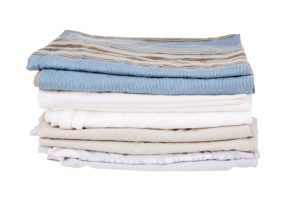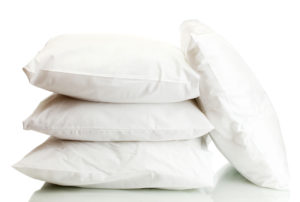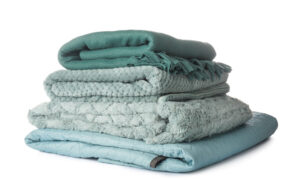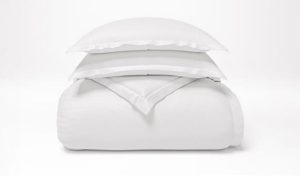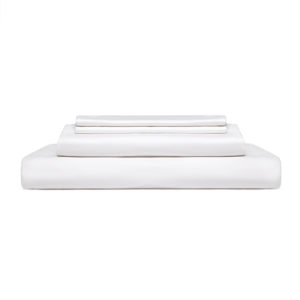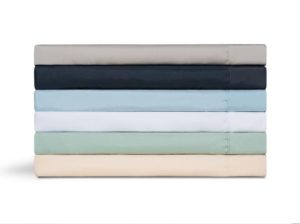How to Wash a Duvet
To wash a duvet, check the care label first for specific instructions. Most duvets can be machine washed in a large-capacity washer using cold or warm water on a delicate cycle with a gentle detergent. Avoid using bleach or fabric softener.
After washing, dry the duvet thoroughly in a large dryer on low heat, adding clean tennis balls or dryer balls to help fluff the filling. Make sure it’s completely dry before using or storing to prevent mildew and clumping.
While people often love their duvets for their thick and cozy feel, duvets are a bit tricky when it comes to laundry time. The cover needs to be removed and washed separately, and the wash instructions for the insert can vary depending on the materials it contains. And when it’s finally washed and dried, you have to wrestle the insert back into the cover. But don’t worry, we’re here to walk you through the process.
Preparing to Wash a Duvet
The first step before washing your duvet is to remove the duvet cover. Next, look for the duvet’s care instructions. Usually, these are found on a label or tag near a corner of the duvet. If you can’t find care instructions on the duvet, visit the duvet manufacturer’s website and look for care instructions.
Your duvet’s care instructions should help you answer these questions:
- Can the duvet be machine washed?
- Should the duvet be washed in a certain water temperature?
- Should the duvet be washed (or not washed) using a particular type of detergent?
- Can the duvet be machine dried?
- Are there any special instructions for removing stains?
Next, look over all of the duvet’s surface for spots or stains. If you find any, you may want to pre-treat them. Lift the fabric away from the fill to avoid getting it wet and apply a small amount of detergent to the stain. Rub the stained area gently and let it soak for 10 to 20 minutes.
Finally, settle on what detergent you’ll use to clean your duvet, based on what the care instructions indicated.
How to Wash a Duvet
Can You Wash a Duvet in the Washing Machine?
Many duvets can be washed in a washing machine. However, it ultimately depends on the materials the duvet contains. Always read care instructions on the label or its manufacturer’s website to see if a specific duvet can be put in a washer. Machine washing a duvet that shouldn’t be machine washed may shrink it or damage its fill.
Machine Washing a Duvet
Washing your duvet insert in a washing machine is generally the easier option, but you only want to machine wash your duvet if its care instructions say that’s okay. The following steps outline how to wash a duvet in a washing machine. If your duvet’s care instructions differ, follow those instead.
What You’ll Need
- Large-capacity washing machine
- Mild detergent
Instructions
Step 1: Put the duvet in the washing machine. Remove the duvet cover and place just the duvet into the washing machine. It should be the only item in the load to give it plenty of room.
Step 2: Add detergent. Use a mild detergent and pour in the recommended amount for a regular load. Add it to the detergent compartment of your machine.
Step 3: Close the door securely. Make sure no part of the duvet is hanging out or bunched near the edges, then close the door firmly.
Step 4: Select the wash cycle. Check the care label for instructions. If it just says “machine wash,” choose a gentle or delicate cycle to protect the filling and fabric.
Step 5: Set the water temperature. Follow the care label for temperature. If there’s no specific guidance, use cool or warm water to avoid damaging the material.
Step 6: Start the wash. Press start and let the machine run its full cycle, including the spin.
Step 7: Remove and dry. Once the cycle finishes, take the duvet out right away and move on to drying—either in a dryer or by air-drying, depending on the care label.
Hand Wash
Some duvet instructions recommend hand-washing rather than machine washing the duvet. While generally this takes more time and effort, following the care instructions is important and can prevent damage.
What You’ll Need
- Bathtub, large sink, large basin, or another container that can fit your entire duvet as well as enough water to cover it
- Water
- Mild detergent
- Washcloth or soft sponge
Instructions
Step 1: Fill your tub or basin with water. Use the water temperature specified in your duvet’s care instructions, whether that’s cold, cool, warm, or hot. Don’t fill the tub or basin all the way to the top, as you’ll need to leave enough room for the duvet.
Step 2: Add detergent. Measure and add the appropriate amount of detergent to the water. Use your hands or a large kitchen spoon to stir the water and mix in the detergent.
Step 3: Put the duvet in the water. Slowly and gently push the duvet into the water, until it’s completely submerged. Gently swish the duvet and water around a bit to ensure the detergent is present throughout the water and soaking into the duvet.
Step 4: Let it soak. Keep the duvet submerged in the water and detergent mix for a few minutes.
Step 5: Clean spots and stains. Lightly clean any stained or spotted areas using a washcloth or soft sponge. Use your washcloth or sponge to gently press and rub on visibly dirty areas until they look cleaner. You may apply a small amount of detergent directly to these areas as you work on them if you didn’t pre-treat them.
Step 6: Empty the water. If you’re using a sink or tub, drain the water. If you’re using another basin or container, empty the water into a sink or tub.
Step 7: Rinse the duvet. Hold the duvet under clean running water of the same temperature to remove detergent. If this isn’t possible, refill the tub with clean water, then empty it again.
Step 8: Remove excess water. Remove water from the duvet by holding it up and allowing water to drip off of it. You may also want to gently squeeze the duvet or press it against the bathtub or sink to push more water out of it. Do not twist or wring the duvet to remove water, as that may compress its fill or change its shape.
How to Dry a Duvet
Is It Okay to Put a Duvet in the Dryer?
Whether or not a duvet can go in the dryer depends on what it’s made of. Often, duvets with down, down alternative, or polyester fill can go in the dryer, while those with wool, silk, or feathers fill cannot. That said, these are not hard-and-fast rules. Always default to the care instructions on your duvet’s label or the manufacturer’s website.
Using a Dryer
Drying a duvet in a dryer is much faster than air drying it. But, you should only select this option if it’s safe for your specific duvet.
What You’ll Need
- Dryer
- Dryer balls (optional)
Instructions
Step 1: Gently shake out the duvet. The duvet may have gotten bunched up or had fill move within it unevenly during washing, especially if you machine washed it. Shaking it out can move the fill evenly throughout it again and help it dry more evenly.
Step 2: Put the duvet in the dryer. Place the duvet in the dryer by itself or, if you prefer, with dryer balls. Adding a dryer ball may speed up the drying process and fluff the duvet. Do not dry it with other bedding, including the duvet cover. Drying the duvet separately from other items can help it dry faster and more evenly.
Step 3: Select your dryer settings. Follow the care instructions for your duvet when selecting the settings. Often, the instructions are to tumble dry on low, but they may differ for your specific duvet.
Step 4: Close the dryer and turn it on. Once you’ve shut the dryer door, push the start button to begin drying your duvet.
Step 5: Check the duvet. After the dry cycle ends, check to see if the duvet is completely dry. If it isn’t, repeat steps 1 through 4 again. Continue doing so until the duvet is totally dry, which may take a few drying cycles. Then, put the duvet cover back on.
Air Drying
Air drying may take longer than machine drying, but it doesn’t risk damaging your duvet. If your duvet is rather large, you may want to ask someone to help with setting it up to dry.
What You’ll Need
- Clothesline, clothes rack, shower bar, drying rack, or other item that you can hang the duvet on while it dries
- Clips or clothespins to keep the duvet in place (optional)
Instructions
Step 1: Shake out the duvet. Unfurl the duvet, so it isn’t folded or twisted.
Step 2: Hang the duvet. Either hang the duvet from a clothesline, or fold it over a drying rack or other object that will allow airflow around it during drying.
Step 3: Secure the duvet. If you’re hanging one end of your duvet from a clothesline or you’re drying your duvet outdoors, you likely need to secure the duvet, so it remains in place as it dries. If you’re folding the duvet over a clothes rack or shower bar and it seems to stay in place well, you may not need to secure it further.
Step 4: Wait for the duvet to dry. Your duvet may take anywhere from a few hours to a full day to dry.
Step 5: Check the duvet. After some time has passed, check your duvet with your hands to see if it’s dry. If you find any damp spots, keep it in place, so it can dry completely. Once dry, remove the duvet from its drying spot.
How to Spot Clean a Duvet
If your duvet care instructions say that it cannot be washed in a washing machine, you may find there are times you’d rather spot clean it than go through the entire hand-washing and drying process.
What You’ll Need
- Stain treatment or mild detergent
- Washcloth or sponge
- Water
Instructions
Step 1: Identify spots and stains. Remove the cover and look over the entire surface of your duvet and identify any places you want to spot clean.
Step 2: Apply stain treatment or mild detergent. Spray stain spray, press a stain pen, or use a washcloth or sponge to apply mild detergent to any spots you want to spot clean.
Step 3: Allow it to sit. Let the stain treatment or detergent sit on the spots for a few minutes, or for however long their instructions specify.
Step 4: Remove the detergent. Lightly wet a washcloth. Using the damp washcloth, gently blot and wipe away the detergent from the spots you treated.
Step 5: Allow the duvet to dry. Do not put a duvet cover back on the duvet until the spots have dried. If there are spots that need to be treated on both sides of the duvet, you may want to spot-treat one side, let it dry, then spot-treat the other side.
Frequently Asked Questions
Should you wash a new duvet?
It’s not 100% necessary to wash a new duvet before using it, especially if it comes in sealed packaging and smells clean and you’re planning on using a duvet cover. However, if you notice any odors, dust, or if you have sensitive skin, washing it before use is a good idea. Washing new bedding helps remove any dust, packaging residue, or manufacturing chemicals, and gives you a fresh, clean start for better sleep.
How often should I wash my duvet?
Duvets should be washed every 6 to 12 months, depending on how much you use them and whether you use a duvet cover. Washing more frequently may be helpful if you have allergies or sleep with pets. If you’re not using a cover or top sheet, you’ll want to wash it every 3 to 4 months.
Is it better to wash or dry clean a duvet?
It’s generally best not to dry clean your duvet, as the harsh chemicals used in traditional dry cleaning can damage the fabric or filling over time. Instead, wash it at home if the care label allows, or take it to a professional laundry service that offers wet cleaning or specialized duvet laundering.
How often should you replace your duvet?
On average, duvets should be replaced every 2 to 5 years. Signs it’s time to replace include flattened filling, persistent odors, or if it no longer keeps you warm evenly.

Still have questions? Ask our community!
Join our Sleep Care Community — a trusted hub of sleep health professionals, product specialists, and people just like you. Whether you need expert sleep advice for your insomnia or you’re searching for the perfect mattress, we’ve got you covered. Get personalized guidance from the experts who know sleep best.








